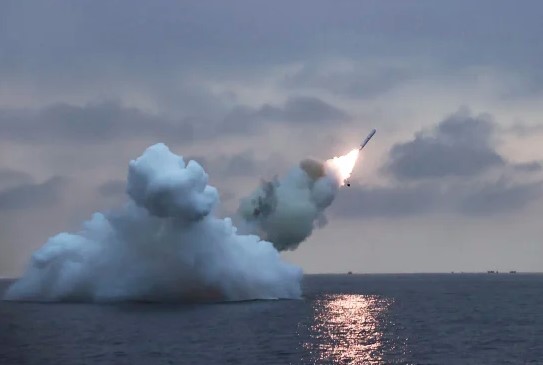North Korea announced that it had successfully carried out a missile test involving sea-to-surface cruise missiles, marking another show of its growing military strength. The missile test took place just before U.S. President Donald Trump’s visit to South Korea, raising tension across the region.
North Korea Conducts Successful Missile Test of Sea-Based Cruise Weapons
According to North Korea’s state-run Korean Central News Agency (KCNA), the missile test was conducted on Tuesday, with the missiles flying for more than two hours before precisely hitting their targets in the country’s western waters. The report claimed that this successful missile test would help expand the operational range of North Korea’s nuclear-armed forces.
South Korea’s Joint Chiefs of Staff (JCS) confirmed that their defense forces detected signs of the upcoming missile test and tracked the launches from North Korea’s northwestern coast around 3 p.m. local time. Both South Korea and the United States are jointly analyzing the weapons’ range, speed, and accuracy. Officials said that their combined defense readiness remains capable of delivering a “dominant response” to any provocation.
North Korea completes missile test of solid-fuel engine amid sanctions and pressure
The missile test shows North Korea’s determination to enhance its sea-based military strike abilities. Cruise missiles differ from ballistic missiles because they fly at lower altitudes, making them harder to detect and intercept. This gives North Korea greater flexibility in its launch operations, allowing it to fire missiles from warships or hidden coastal sites.
The timing of this missile test, carried out shortly before Trump’s visit, appears intentional. It sends a message of defiance and demonstrates Pyongyang’s readiness to project power at moments of high international focus.
Trump Downplays Missile Test During His Asia Visit
Donald Trump, who is touring Asia, downplayed the latest missile test when questioned by reporters aboard Air Force One. While traveling from Japan to South Korea, Trump said North Korea’s leader had been “launching missiles for decades,” implying that such actions were not new. His remarks suggested that he did not view this particular missile test as a serious escalation.
Trump recalled his earlier meetings with North Korean leader Kim Jong Un in 2018 and 2019, saying the two had a “good understanding” during their past diplomacy. However, those talks broke down due to disagreements over U.S.-led sanctions and demands for North Korea’s denuclearization. Since then, communication between the two countries has been minimal.
South Korea finalizes UN draft resolution on Iran sanctions amid snapback process
During this trip, Trump is expected to participate in the Asia-Pacific Economic Cooperation (APEC) summit in Gyeongju and meet with South Korean President Lee Jae Myung. Discussions with Chinese President Xi Jinping are also planned, but a Trump-Kim meeting appears unlikely.
The missile test occurred at a politically sensitive moment, coinciding with Trump’s presence in the region. Analysts view such actions as a pattern, where North Korea conducts tests to assert its military might and remind other nations of its growing capabilities.
South Korean defense authorities confirmed that their surveillance systems remain fully active and that U.S.-South Korean military cooperation continues to ensure regional stability. Both allies have been closely monitoring North Korea’s activities following this missile test, keeping their forces ready to counter any additional launches.
Rising Tensions and Expanding Military Capabilities
KCNA reported that senior military official Pak Jong Chon attended the recent missile test and inspected naval training aboard North Korea’s newly developed destroyers Choe Hyon and Kang Kon. These modern warships are viewed as key elements in Kim Jong Un’s efforts to strengthen North Korea’s naval power and expand its missile-launch capabilities at sea.
The missile test followed another round of short-range ballistic missile launches conducted last week. North Korea claimed that those tests featured a new hypersonic missile system, which it described as essential for boosting its nuclear deterrent strength.
In recent years, North Korea has invested heavily in developing both land- and sea-based missile systems, despite facing international sanctions. The country’s continuous missile tests highlight its commitment to modernizing its arsenal and achieving greater precision in its weapon technology.
Diplomatic relations between North Korea, South Korea, and the United States have remained at a standstill since 2019. That year, Kim Jong Un demanded sanctions relief, while the United States insisted on steps toward denuclearization. Since then, North Korea has cut off official communication channels with both countries.
NATO sidesteps North Korea’s war role—even as 14,000 troops back Russia in Ukraine
In recent months, Pyongyang has deepened ties with Russia, sending ammunition and troops to aid Moscow’s war in Ukraine. The alliance shows Kim’s effort to align with powers opposing Western influence.
Kim maintains that North Korea will not resume talks with the United States unless Washington drops its denuclearization demand. Instead, the country continues to display its strength through repeated missile tests and naval drills.
Each missile test acts as both a technical trial and a political message, highlighting North Korea’s growing military power and the tense balance on the Korean Peninsula during Trump’s South Korea visit.

